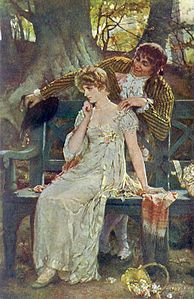Henrietta Rae
Henrietta Rae | |
|---|---|
 Henrietta Rae, date unknown | |
| Born | Henrietta Emma Ratcliffe Rae 30 December 1856 Hammersmith, London, England |
| Died | 26 January 1928 (aged 71) Upper Norwood, England |
| Nationality | British |
| Education | Academy Julien, Paris |
| Known for | Painter, writer |
| Notable work | The Lady with the Lamp |
| Movement | Victorian art |
| Spouse(s) | Ernest Normand, painter (1857–1923) |
Henrietta Emma Ratcliffe Rae (30 December 1856
Biography
Henrietta Rae was born on 30 December 1856 in Hammersmith, London, to Thomas Burbey Rae, a civil servant, and Ann Eliza Rae (née Graves), a musician who had been a student of Felix Mendelssohn. She had three brothers and three sisters.[2][4][5]
Rae began formally studying art at the age of thirteen, being educated at the Queen Square School of Art,

In 1884 she married painter and fellow Royal Academy student
Rae and Normand travelled to Paris in 1890 to study at the Académie Julian with Jules Joseph Lefebvre and Jean-Joseph Benjamin-Constant. In 1893, they moved to Upper Norwood, into a studio that was custom-built for them by Normand's father. The couple had two children, a son (born in 1886) and a daughter (born in 1893).
Rae exhibited her work at the Palace of Fine Arts and The Woman's Building at the 1893 World's Columbian Exposition in Chicago, Illinois.[9]
Rae was a supporter of
She died on 26 January 1928 at Upper Norwood.
Works
Rae specialised in classical, allegorical and literary subjects. Her painting Elaine Guarding the Shield of Lancelot (1885) drew inspiration from the
Rae's Psyche at the Throne of Venus (1894) measures 12 by 7 feet (370 by 210 cm) and contains 13 figures.
Her works include:
- Love's young dream (1883)
- Elaine guarding the shield of Lancelot (1885)
- Ariadne (1885)
- Eurydice Sinking Back to Hades (1886)
- Zephyrus and Flora (1888)
- Miss Nightingale at Scutari (1854)(1891)
- Psyche at the throne of Venus (1894)
- Apollo and Daphne (1895)
- Diana and Calisto (1899)
- Sir Richard Whittington dispensing his Charities (1900) Mural at the Royal Exchange, London
- The Marquess of Dufferin and Ava (1901)
- Hylas and the water nymphs (1910)
- John Horner 1858-1919 (1913; Ulster Museum, Belfast)[12]
Gallery
-
A Bacchante (1885)
-
Doubts (1886)
-
Azaleas (1895)
-
Ophelia (1890)
-
Zephyrus Wooing Flora (c. 1900)
-
Venus Enthroned (1902)
-
The Sirens (1903)
-
Isabella (1905)
References
- ^ Birth certificate gives date of birth as 30 December 1856. Other sources give a later year.
- ^ a b Arthur Fish, Henrietta Rae (Mrs. Ernest Normand), London, Cassell & Co., 1905.
- ^ Deborah Cherry, Painting Women: Victorian Women Artists, London, Routledge, 1993.
- JSTOR j.ctt1cgdwwm.
- ^ "Henrietta Rae". Art Renewal Center. Retrieved 20 February 2017.
- ^ Caroline Dakers, The Holland Park Circle: Artists and Victorian Society, New Haven, Yale University Press, 1999.
- ^ Fish, p. 47.
- ^ Debra Mancoff and D. J. Trela, eds., Victorian Urban Settings: Essays on the Nineteenth-Century City and Its Contexts, London, Taylor & Francis, 1996; p. 71.
- ^ Nichols, K. L. "Women's Art at the World's Columbian Fair & Exposition, Chicago 1893". Retrieved 30 July 2018.
- ISBN 978-1-4766-2604-8. Retrieved 20 February 2017.
- ^ Meaghan Clarke, Critical Voices: Women and Art Criticism in Britain 1880–1905, London, Ashgate, 2005; p. 99.
- ^ "John Horner (1858–1919) | Art UK". artuk.org. Retrieved 11 April 2019.
External links
- Henrietta Rae @ Victorian Artists.
- "Into the Light", Henrietta Rae and the Academic Nude @ Eclectic Light
- 20 artworks by or after Henrietta Rae at the Art UK site








